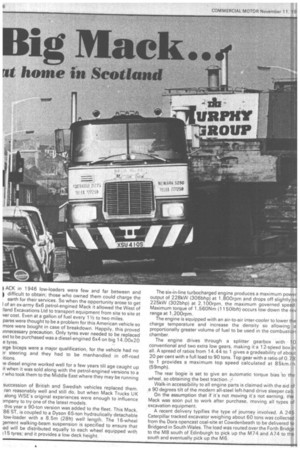Big Mack
Page 28

Page 29

If you've noticed an error in this article please click here to report it so we can fix it.
ACK in 1946 low-loaders were few and far between and difficult to obtain; those who owned them could charge the earth for their services. So when the opportunity arose to get I of an ex-army 6x6 petrol-engined Mack it allowed the West of :land Excavations Ltd to transport equipment from site to site at yer cost. Even at a gallon of fuel every 11/2 to two miles.
pares were thought to be a problem for this American vehicle so more were bought in case of breakdown. Happily, this proved innecessary precaution. Only tyres ever needed to be replaced ext to be purchased was a diesel-engined 6x4 on big 14.00x20 e tyres.
Irge biceps were a major qualification, for the vehicle had no .3r steering and they had to be manhandled in off-road itions.
le diesel engine worked well for a few years till age caught up it when it was sold along with the petrol-engined versions to a r who took them to the Middle East Where they may be running succession of British and Swedish vehicles replaced them. ran reasonably well and still do, but when Mack Trucks UK along WSE's original experiences were enough to influence )mpany to try one of the latest models.
this year a 90-ton version was added to the fleet. This Mack, 86 ST, is coupled to a Dyson 65-ton hydraulically detachable low-loader with a 8.5m (28ft) well length. The 16-wheel ]ement walking-beam suspension is specified to ensure that .ad will be distributed equally to each wheel equipped with t15 tyres; and it provides a low deck height. The six-in-line turbocharged engine produces a maximum power output of 228kW (306bhp) at 1,800rpm and drops off slightly to 225kW (302bhp) at 2,100rpm, the maximum governed speed. Maximum torque of 1,560Nm (1150Ibft) occurs low down the rev range at 1,200rpm.
The engine is equipped with an air-to-air inter-cooler to lower the charge temperature and increase the density so allowing a proportionally greater volume of fuel to be used in the combustion chamber.
The engine drives through a splitter gearbox with 10 conventional and two extra low gears, making it a 12-sPeed box in all. A spread of ratios from 14.44 to 1 gives a gradeability of about 20 per cent with a full load to 90 tons. Top gear with a ratio of 0.78 to 1 provides a maximum top speed calculated at 85km / h (59mph).
The rear bogie is set to give an automatic torque bias 'to the wheel, so obtaining the best traction.
Walk-in accessibility to all engine parts is claimed with the aid of .a 90 degrees tilt of the modern all-steel left-hand drive sleeper cab
On the assumption that if it's not moving it's not earning, the Mack was soon put to work after purchase, moving all types of excavation equipment. A recent delivery typifies the type of journey involved. A 245 Caterpillar tracked excavator weighing about 60 tons was collected from the Dora opencast coal-site at Cowdenbeath to be delivered to Bridgend in South Wales. The load was routed over the Forth Bridge to the MB south of Edinburgh to pick up the M74 and A74 to the south and eventually pick up the M6. Diversions operating in the Midlands meant a delay to the start of the third day while waiting for the fog to clear, and the go-ahead from the police to proceed. The vehicle reloined the motorway network back on the M5 and then went onto the M50 until the A449; then it crossed on the to the M4 and took the last leg along A48 to Bridgend. It was all in a week's work at 12mph, or a bit quicker at the po escort's discretion.
















































































































































































































































